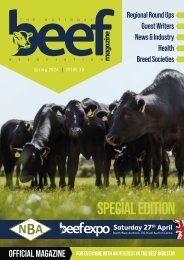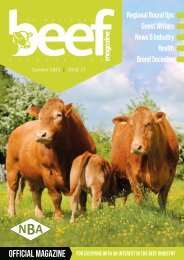NBA Winter Magazine_2023_
For everyone with an interest in the British Beef Industry
For everyone with an interest in the British Beef Industry
Create successful ePaper yourself
Turn your PDF publications into a flip-book with our unique Google optimized e-Paper software.
Highland | Breed Society Focus<br />
How suited are Highland Cattle<br />
to a grass-fed system and genetic<br />
selection?<br />
Highland cattle are well-suited to a grass-fed system<br />
as they are adapted to grazing on rough terrain and<br />
can thrive on a diet of grass and other forage. Their<br />
long, shaggy coats help them to withstand cold and<br />
wet weather, which can be beneficial in regions<br />
where grazing is possible for a long season. In<br />
addition, they are generally hardy, low-maintenance,<br />
and do not require a lot of inputs such as grain or<br />
supplements to produce high-quality beef. Being<br />
able to live outside all year means a large reduction<br />
in bedding costs.<br />
Highland cattle are also well-suited to genetic<br />
selection as they are a purebred breed with a<br />
distinct set of desirable traits. For example, they<br />
are known for their excellent meat quality, with a<br />
fine-grained texture, high marbling, and rich flavour.<br />
They are also efficient at converting grass to meat,<br />
which can be an important consideration in a grassfed<br />
system. You can also utilise any rough grazing<br />
as Highlands will convert all types of rough forage,<br />
such as moorland and woodland pasture. Use of<br />
costly fertiliser can be minimised or eradicated<br />
completely.<br />
Additionally, Highland cattle are known for their<br />
maternal qualities, producing calves with a high<br />
survival rate and good growth potential on a grass<br />
fed system.<br />
One thing that is often overlooked is cow production<br />
replacement costs. A Highland cow will, in the<br />
majority of cases, keep calving until their late teens,<br />
meaning they have around 10-15 healthy calves (or<br />
more) during their lifetime. Meaning less frequent<br />
need to replace the cows in the herd and therefore<br />
lower replacement costs.<br />
They are also the ideal animal for conservation<br />
grazing and pasture improvement commanding<br />
additional income depending on the types of<br />
payments available in each country or availability of<br />
land needing this sort of treatment.<br />
It is important to note that genetic selection for<br />
certain traits can take time and careful planning.<br />
It is important to select animals based on a range<br />
of traits that are important for your operation and<br />
the market you are serving. Additionally, it may<br />
be necessary to bring in new genetics periodically<br />
to maintain genetic diversity and improve traits<br />
such as growth rate and meat quality. Care must<br />
be taken at all times to maintain the good traits.<br />
The Highland Cattle Society are slowly introducing<br />
genetic measurements. Results so far show higher<br />
stay ability and milkiness than the average herd of<br />
suckler cows.<br />
Overall, Highland cattle can be well-suited to a<br />
grass-fed system and genetic selection, and can<br />
produce high-quality beef, demanding a premium<br />
price, in an efficient and sustainable manner.<br />
For further information please visit the Highland<br />
Cattle Society website www.highlandcattlesociety.<br />
com or telephone the Breed Secretary Anne-Marie<br />
Carruthers on 01786 446866.<br />
WINTER <strong>2023</strong> | The National Beef Association <strong>Magazine</strong><br />
33






